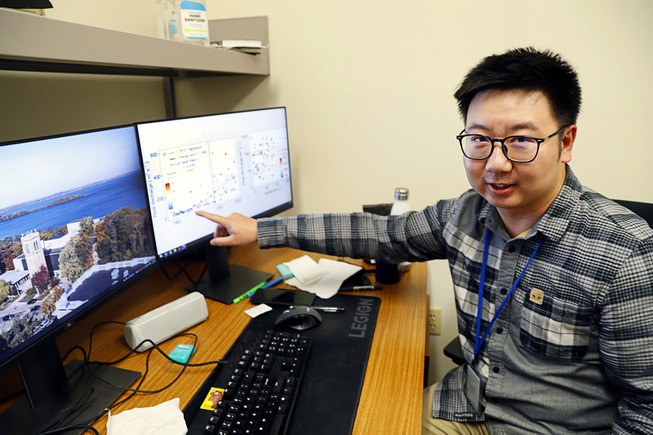
Guo Yu, a scientist at the Desert Research Institute, points to a graph showing stream flow between 1960 and 2020 during an interview at the institute Wednesday, Jan. 25, 2022.
Tuesday, Feb. 7, 2023 | 2 a.m.
The flooding in Las Vegas that accompanies those summer monsoon cloudbursts might also occur in the winter in future years, according to one researcher’s findings.
Guo Yu, a hydrologist at the Desert Research Institute, led a study on flood patterns in the Las Vegas Valley that predicts winter floods will become more frequent across the Southwestern United States in the next couple of decades.
The way flooding occurs in dry metropolitan areas like Phoenix and Las Vegas is similar to a food recipe, he said, with many elements that can mix to create certain scenarios.
“When you cook food, you need to follow the recipe to make the food, like the flour, fat … and that’s the homemade results you’ve got,” Yu said. “For (this project), I refer to it as a flood recipe — we choose how that streamflow came in (and) how they are resulted from.”
The recipe, according to Yu’s study, involves a few major ingredients: climate change, urbanization and Clark County’s flood infrastructure.
Since the 1950s, Las Vegas has seen “some of the fastest urbanization of anywhere in the United States” despite the threat of flash flooding and extreme rainfall, the study said. Climate change could cause a rise in atmospheric rivers — the weather pattern that causes winter storms — throughout the Western United States, which means more rain ending up in county flood channels, according to Yu’s study.
These atmospheric rivers typically start in California and lose their intensity as they move east over the Sierra Nevadas, but a strong enough storm can still leave an impact on Las Vegas, Yu said.
Expanding the Las Vegas area means building more properties and businesses, which can alter the ground composition and make it harder for water to become absorbed. It also creates more need for flood mitigation systems — the channels across the valley that direct runoff water.
Yu said that flood channels and water detention basins can help deliver and retain water to areas where it’s needed, like Lake Las Vegas and Lake Mead, but the materials used to build them prevent water from seeping into the ground.
“You build those concrete pavements and replace what it used to be – the desert soil — which means you have no storage of (that) precipitation under the ground, but now the flow (is) on the ground, so the volume of those floods increases,” Yu said. This means one strong storm has the possibility of overwhelming some channels, Yu said.
But the Clark County Regional Flood Control District has “a lot of confidence” that its facilities will be able to weather any future storms, said Steve Parrish, the flood district’s general manager.
Parrish said the study’s findings were “probably not going to change much” of the design process used for building the county’s flood infrastructure, especially because the flood district was already “very conservative” with its projects.
This includes creating “oversized” rainfall capture facilities that can hold more rainwater than Clark County already receives annually, Parrish said. Since the start of Clark County’s flood infrastructure design, Parrish said the flood district has used the “100-year flood” concept — a term used to describe the possibility that a severe flood has a 1% chance of occurring in any year.
The 100-year flood also helps with determining risk percentages for flood insurance rates by establishing base flood elevation levels in a given area, according to the National Flood Insurance Program.
Although the science behind the term has been debated, Parrish doesn’t believe it will phase out of local flood infrastructure mapping any time soon, even with an increase of winter floods.
“It’s very hard for us to design something now for something that might occur in the future and spend tax dollars on that, (so) we’re just looking at making sure that the facilities we are designing are robust,” Parrish said.
Despite the confidence in county flood management, Yu said, residents should also “pay more attention” to winter floods.
He believes many people tend to underestimate winter floods because the rain is less intense and happens over a longer period of time than summer monsoons. Winter storms move slower than those summer rains, but can still cause damage, he said.
“The hazard of those winter floods has always been overlooked by the public, and I think that’s an issue when the climate is changing,” Yu said. “We are trying to do our best to do more outreach and transfer the knowledge from research to the public.”

